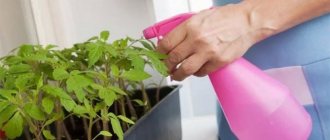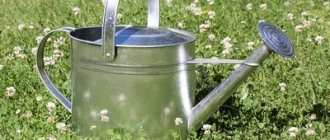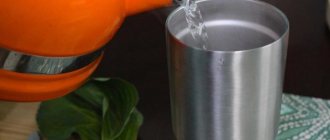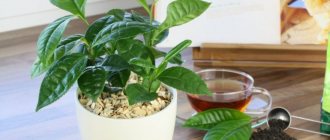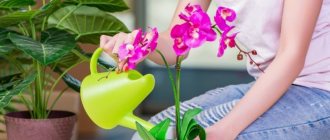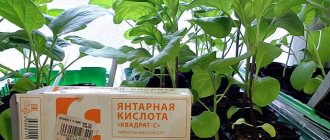◾spraying flowers with a solution of succinic acid even once every few weeks will significantly enhance their growth and development. ... To achieve this, spraying can be carried out before flowering begins, and the treatment can be carried out several times. Water the ground under the violet with a working solution once a month. Succinic acid is used on violets once a month. The composition of succinic acid mixed with potassium humate in a 1:1 ratio shows high efficiency. This will greatly strengthen the immune system and activate flower growth.
How to dilute Amber for indoor plants?
Solution – 0.4 g/1 l of water (80 ml of Amber per 1 l of water). Treatment - immersing the plant “upside down” in the solution so that it does not get into the axils of the leaves. Processing time is half an hour.
Interesting materials:
What percentage of women cheat on their husbands? What is the cost of living in Belarus 2022? How long will your SSD last? How many posts can you post on Instagram? How many empty pallets are included in a gazelle? How long does it take for dental sutures to dissolve? How many times has Messi won the Golden Boot? How many times can you use the same sheet mask? How many times do you have to do pull-ups in the army? How many times a day should you feed the praying mantis?
Succinic acid for violets
This is a natural compound that is present in small concentrations in the cell of every living organism. It is a regulator of energy metabolism necessary for the body to obtain vital energy.
Characteristics
Succinic or butadionic acid (C4H6O4) belongs to the group of dibasic saturated carboxylic acids. It is a by-product of amber processing; industrially it is obtained through chemical synthesis.
Succinic acid.
The acid is a white, translucent crystalline substance easily soluble in water, alcohol and ether.
In plant growing it is used only in the form of aqueous solutions. This compound is especially useful when caring for potted plants, where there is no natural supply of beneficial elements and microorganisms.
Release form
Succinic acid is available in the form:
- tablets of 50 and 100 mg in blister;
- powder, packaged in plastic bags of 1, 5, 10, 25 kg.
It is used in very small doses, so it is better to purchase the drug in tablet form.
Features and Properties
The features of succinic acid as a plant biostimulator are determined by its natural origin:
- due to its weakly expressed stimulating effect, it can be used to treat all parts of the plant ;
- application of the drug promotes the development of soil microflora ;
- acid does not accumulate in soil and plants and quickly decomposes under natural conditions;
- low cost of the drug.
Attention! The drug cannot be used as a supplement; it is effective as a stimulant in recommended concentrations.
A positive result will be noticeable within a month. And you can be absolutely sure that there will be no negative consequences for your flower.
Advantages and disadvantages
The biostimulator has a wide spectrum of action , under its influence:
- immunity is increased and the risk of flower damage by pests and microbial infections is reduced;
- cellular metabolism is activated, as a result, the growth of the above-ground and root parts of plants is accelerated;
- improves the absorption of nutrients by roots;
- stimulates chlorophyll synthesis in leaves;
- promotes rapid recovery of the flower after stress caused by transplantation or change in conditions.
Succinic acid can be used for any plants.
Notable disadvantages include:
- relatively weak overall effect on the plant;
- increasing soil acidity with repeated use, this is especially true for potted crops.
To avoid soil acidification, it is necessary to control the pH of the soil and, if necessary, carry out liming.
Negative consequences of improper watering
How to water gooseberries in summer - the best watering methods
Lack of moisture or its excess has a bad effect on the condition of the violet, leading to gradual death:
- Excessive moisture - the roots die, spots appear on the leaves. This occurs due to the fact that water stands in the ground, preventing nutrients from passing through.
- Flooding of flower organs during top watering means rotting of the growing point.
- If water gets on the leaves when watering from above, brown and yellow spots appear.
- Lack of water - leaves wither and fall off.
- Using too hard a liquid will result in a yellow-white crust appearing on the top layer of soil.
- Infrequent watering - a space is formed between the soil and the walls of the container.
Improper watering leads to the slow death of the plant.
Excessive watering can lead to the appearance of mold on the ground. Because of it, the soil is less permeable to air, and the roots cannot fully “breathe.”
During what periods is it better to refrain from fertilizing?
You should not feed violets at the development stage.
The plant may not always need feeding:
- transplanted plants. A month for sure. Or even more;
- After purchasing in the store, do not start fertilizing for 2-3 weeks;
- If temperatures from the recommended ones;
- Stop feeding if you find bugs, mites, aphids or other unwanted guests;
- nitrogen fertilizers when buds appear;
- Fertilizers should not be applied to dry soil. First, water with plain water.
Reviews
Ekaterina, Kamen-on-Obi. “I’ve been meaning to try succinic acid for a long time to boost the immunity of flowers. I bought it at the pharmacy, it wasn’t expensive at all, which made me very happy. I watered and sprayed my violets, as well as other plants, according to the instructions. A month later, I also noticed that the leaves became bright green and the bush was lush. Now, after purchasing, I also treat all new flowers with succinic acid. This flower tolerates stress more easily and in rare cases begins to hurt. So I'm very pleased."
Stanislav, Ivanovo. “They gave me a young rosette and it soon fell ill with bacteriosis; within a day the stem turned brown and the disease began to spread to the leaves. I just didn't know what to do to save the flower. They advised to spray it with succinic acid. This stopped the spread of infection. As a result, I managed to root the top of the violet. But bacteriosis could destroy a flower in just one day.”
Margarita, Ulyanovsk. “As soon as I noticed that the Uzambara violet began to grow poorly, was producing weak leaves, and was not blooming, I decided to test succinic acid and watered it twice a month. Three months later, the violet bloomed for the first time, it was a real miracle. It became noticeable how the color of the leaves became saturated with green. We can conclude that the drug really works.”
Processing methods
Amber can be used for various purposes. It is suitable not only for watering or spraying plants.
Amber is used for spraying garlic or treating it before planting in the soil.
Main uses:
- Watering. This is done using a special watering can or a small mug/glass. You can apply the drug only at the root, avoiding drops on leaves or flowers.
- Soaking the roots. It is performed before planting seedlings into the ground, as well as, if necessary, to resuscitate a dying plant. In the first case, it is enough to hold the roots of the crop for a few minutes, then plant it in the soil. When using the drug for medicinal purposes, the course of procedures is longer (see above).
- Wiping leaves. This method of using Yantarine is more suitable for treating indoor plants. A cotton pad is moistened in the solution prepared according to the instructions, after which each leaf is wiped separately. Direction - from base to top. You need to process on both sides, gradually increasing the pressure. As a result, the last drops of the product should drain from the surface of the leaves.
- Spraying. Performed according to the sheet. During the procedure, you need to carefully process the leaves and stems of the plant.
Important! After using the solution to resuscitate plants, you must wait until their permanent flowering is established. And only after this is it possible to transplant them into a pot or artificial substrate.
Conditions of detention
After buying a violet in a store, leave it for 2 months isolated from other plants in the house to avoid the transmission of possible diseases or parasites. If not a separate room, then at least a place distant from the flower garden would be suitable. If you bought a violet from a private grower you trust, then you can choose a permanent place for it right away. The table presents recommended and non-recommended requirements for keeping violets at home.
| Violets love... | Violets do NOT like... |
| Lots of sunshine | Direct sunlight, especially at midday - leaves can get burned |
| Daylight hours are about 13 hours and additional illumination with phytolamps in winter (only under this condition will violets bloom in the cold season) | Drafts and sudden temperature changes. For this reason, it is better not to place violets on an open balcony in the summer. |
| Room temperature is about 24 degrees or slightly lower in winter | Cool air below 15 degrees. In such a climate, violets stop growing and blooming. |
| High air humidity | Drops of water on leaves and flowers. Therefore, Saintpaulias do not need spraying |
The blooming of homemade violets greatly decorates the windowsills. And due to the fact that Saintpaulias are usually small in size, this plays into the hands of owners of small apartments.
In summer, it is not advisable to place violets on an open balcony, since they do not tolerate temperature changes at night very well. But on the loggia (see photo below), where the temperature does not drop below 15 degrees, violets will feel good.
If you want violets to bloom in winter, provide them with additional lighting with LED or phyto lamps.
Feeding calendar
Every violet lover strives to develop a certain correct regime of fertilizing by watering. And the need for them at different stages of development is far from the same. The exact time of feeding depends on many factors :
- Phase of plant development (young, growing season, budding, flowering, after flowering). His condition. And the time of year must be taken into account;
- Features and recommendations for the use of a specific drug;
- Your employment;
- The plant needs two feedings per month.
If you water weekly . Reduce concentration by half.
Forum of flower growers Frau Flora
About growing indoor and garden plants; discussion of species, varieties, diseases, pests.
- Unanswered topics
- Active topics
- Search
- About Us
succinic acid
Moderator: Murzilka
succinic acid
Post by qwestxxx » Feb 23, 2022 12:57 pm
Succinic acid I am interested in the topic of fertilizing indoor plants with succinic acid. I bought succinic acid in liquid form at the store. And I can’t find anywhere how to dilute it (for example, for orchids, violets, and in general for different indoor flowers); everywhere they give proportions for powder or tablets. But how to dilute liquid? in what proportions? How often should I water the plants? There is a general table in the instructions for use that is not at all informative. Maybe in this form it is not suitable for indoor plants at all?
succinic acid
Post by Lucina » 23 Feb 2022, 13:17
succinic acid
Message by LoveN » 23 Feb 2022, 13:37
succinic acid
Post by Lucina » 23 Feb 2022, 15:31
succinic acid
Post by GalinaGala » 23 Feb 2022, 17:49
succinic acid
Post by Lucina » 23 Feb 2022, 20:06
Fertilizers for indoor plants
Post by Lucina » 24 Feb 2022, 15:26
succinic acid
Post by Florian » 24 Feb 2022, 16:15
Peculiarities
This beauty needs careful care. Born in the Ulugur and Uzambara mountains of Tanzania, where warmth and moisture reign, in local latitudes it does not live in open spaces. When growing indoors, it requires certain knowledge and skills.
It does not cause allergies and blooms without smell. Being in a children's room will not provoke an exacerbation of the disease in an allergy or asthma sufferer. Releases phytoncides that kill and inhibit the growth of pathogenic bacteria. With proper care it blooms 10 months a year.
It is often confused with flowers of the violet family called Pansies, which grow in gardens and forests. They are unpretentious and grow well in northern regions, continental climates, tropics and subtropics, at high altitudes in mountains and river valleys. A native of Africa, Saintpaulia, has no family ties with them.
Instructions for use
Depending on the goal, violet processing is carried out in different ways. Before starting work, prepare a working solution.
Preparation of working solution
The finished solution can contain from 0.01 to 0.1% of the active substance, the universal solution contains 0.02% acid. The acid concentration in the solution is:
- for wiping the leaf blade 2 g / liter of water;
- when spraying – 2 g/liter of water;
- when watering the roots - 3 g/liter of water;
First prepare the concentrate:
- 1 g of the substance is dissolved in 50 ml of warm water;
- add cold water to a liter.
To obtain a 0.02% working solution, add 0.8 liters of cold water to 200 ml of the resulting concentrate.
Based on the data obtained, you can calculate how to use succinic acid for violets in tablets, knowing the dosage of the active substance. So, with a tablet dosage of 100 mg, to obtain 1 g of succinic acid you need to take 10 tablets.
The prepared solution is stored for no more than 3 days; at the end of this period it is poured out.
Watering
Water the ground under the violet with a working solution once a month.
Succinic acid is used on violets once a month.
The composition of succinic acid mixed with potassium humate in a 1:1 ratio shows high efficiency. This will greatly strengthen the immune system and activate flower growth.
Spraying
At the first signs of violet disease, it is recommended on both sides once or twice a month . If necessary, the number of treatments can be increased.
Important! Constant stimulation of the violet exhausts the plant and disrupts its natural rhythm.
It is enough to spray a healthy plant once a month.
Stimulation of flowering
On gardening forums, succinic acid for violets and how to make them bloom are often discussed. It is worth understanding that there is no panacea in this matter, however, spraying violets before flowering begins to noticeably affect the development of buds:
- their number increases;
- the leaves become bright green.
The use of succinic acid makes flowering more magnificent.
Before flowering, treatment is carried out once a week.
Increased root formation in cuttings and children
Treatment of the root system before planting violets promotes rapid rooting of the flower:
- the root is immersed in the working solution for 60 minutes;
- dry for about half an hour;
- The violet is planted in the soil mixture.
In order for the rooting of cuttings to be successful, a cut of the cutting is immersed 2 cm in a working acid solution, the exposure time is several hours.
From time to time, daughter plants - stepchildren - develop from the buds located between the leaves of the violet. They are usually removed to leave one growing point, but they can also be used for propagation.
In this case, the formation of stepsons on the violet can be stimulated by pinching the growing point or cutting off the top of the rosette, which can then be rooted. Such manipulations initiate the growth of a large number of stepchildren.
Overdose
Exceeding the dosage of the drug does not pose any risks for violets , since the roots are able to absorb only a small part of this compound.
Possible harm
An overdose of succinic acid does not have a negative effect on plants. They use the amount of feeding they need.
But when spraying, you should not overdo it with the concentration of the beneficial substance. A strong solution may leave burns on the foliage.
Frequent use of succinic acid solution leads to soil oxidation. To combat this effect, you can use lime by adding it to the substrate.
Succinic acid helps stimulate the necessary life processes of flowers. It can be used for healthy cultures and treatment, resuscitation of needy specimens.
For each case, a solution is prepared with a different concentration of dicarboxylic acid. A strong acidic composition will be required in the fight against pests and infections. When caring for and stimulating flowering, weak mixtures are sufficient.
Dicarboxylic acid can be used for watering, spraying and soaking plants. But it is necessary to observe the correct dilution proportions and frequency of application of fertilizing.
Otherwise, you can achieve a negative effect. Choosing food for indoor plants is not easy. It is the amber composition that compensates for the lack of nutrients in the soil.
What kind of water is suitable
For humidification, soft water, two degrees above room temperature, is suitable. This flower should not be watered with a cold solution. Using rainfall or melting snow is impractical and harmful. The ecology of many cities and regions is not always suitable for this. Most of the elements from the periodic table end up on the continent with atmospheric phenomena, and not the most useful ones.
Centralized water supply to homes is produced with increased levels of calcium, magnesium, and sulfate bicarbonates. The water becomes hard and leaches the soil. The earth is changing its chemical composition. From slightly acidic, favorable for violets, it becomes neutral or has increased alkalinity. This also provokes the death of the plant.
Humidification with a distilled solution is a bad option. Distilled water is sterile, without salts, so it actively absorbs them from the soil. Its constant use leads to the depletion of the land. Such water washes away all salts - both harmful ones that leach the surface, and useful ones, for example, fertilizers applied for feeding. The plant is hungry. It grows and blooms worse.
The softness of water is achieved by boiling. The bulk of the salts will precipitate. The resulting liquid must be acidified. It is not advisable to constantly pour such a cocktail.
But there is still a solution to the problem: to defend the life-giving moisture running from the tap:
- take a clean container and fill it with tap water;
- cover the dishes loosely and leave them alone for two days;
- heavy metal salts and impurities will settle to the bottom, and the bulk of the chlorine will evaporate;
- It is reasonable to use only 2/3 of the resulting volume, and pour out the remainder with settled toxic components.
Once every 6 weeks, water your pet with boiled water. Add a pinch of citric acid or 1 teaspoon of apple cider vinegar per liter.
